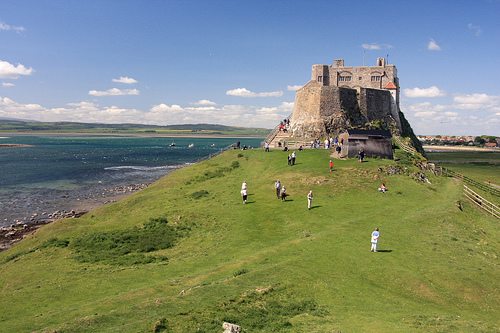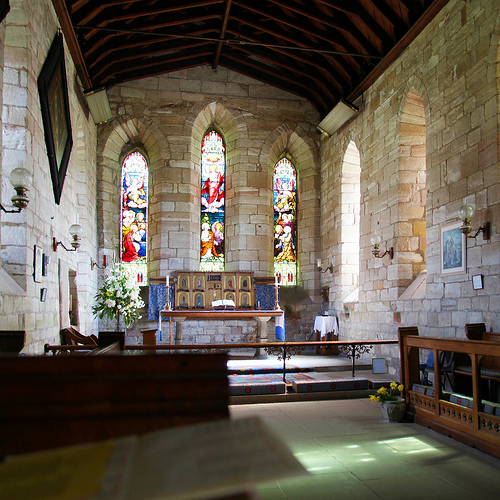

Location: Holy Island, Northumberland Map
Tel. 01289 389244
Constructed: 1550
Entrance Fee: adult
£4.40
Children (5- 15 years) £2.60
Lindisfarne Castle is a 16th-century fortification located on
Holy Island (also known as Lindisfarne), a tidal island off the
coast of Northumberland, England, near Berwick-upon-Tweed.
Perched dramatically on Beblowe Crag, the highest point on the
island at about 100 feet (30 meters) above sea level, the castle
offers panoramic views over the North Sea, Lindisfarne Harbour,
and the surrounding coastline, including distant sights of
Bamburgh Castle. The island itself measures roughly 3 miles (5
km) long and 1.5 miles (2.4 km) wide, with coordinates
approximately 55°40′08″N 1°47′06″W. Access is via a 2-mile (3.2
km) causeway from the mainland, which is submerged twice daily
by tides, requiring visitors to check safe crossing times to
avoid being stranded. This isolation enhances the castle's
romantic and rugged appeal, blending natural defenses with
historical significance. Originally constructed as a military
outpost during Anglo-Scottish border conflicts, it was
transformed in the early 20th century into an Arts and
Crafts-style holiday home by architect Sir Edwin Lutyens and
garden designer Gertrude Jekyll. As of 2025, it remains a key
visitor attraction managed by the National Trust, with ongoing
preservation efforts and special events highlighting its
heritage.
The surrounding landscape includes sandy
beaches, dunes, a nature reserve supporting birdwatching and
seal spotting, and industrial remnants like 19th-century lime
kilns at Castle Point, now a Scheduled Ancient Monument. These
kilns, built in 1860 by William Nicoll, employed up to 35 men
and produced quicklime for industries such as steelmaking and
agriculture until around 1900. The site's exposed position
subjects it to harsh coastal winds, contributing to its
windswept, elemental character, which has inspired artists and
filmmakers over the years.
The castle's history is rooted in Holy Island's early Christian
heritage and the turbulent Anglo-Scottish border region. In the 7th
century, St. Aidan founded a monastery, later linked to St. Cuthbert,
making it a center of Celtic Christianity. Viking raids began in 793 AD,
devastating the community and leading to the monks' relocation of St.
Cuthbert's relics to Durham. A Benedictine priory was re-established
post-Norman Conquest but faced Scottish raids in the 14th century,
resulting in fortified monastic structures. The priory was dissolved in
1537 during Henry VIII's Reformation, with its stones repurposed for
defenses.
Construction of the fort began in 1542 when Henry VIII
commissioned Thomas Manners, 1st Earl of Rutland, to fortify Beblowe
Crag against Scottish threats. By 1547, under Captain Ralph Cleisbye, it
was armed with artillery like demi-culverins and sakers. Sir Richard Lee
surveyed it in 1565, noting decay, prompting Elizabeth I's £1,191
investment in 1570–1571 for stone reinforcements and gun platforms. This
established it as an Elizabethan fort, garrisoned for over 300 years
(1550s–1893) with up to 21 cannons, protecting the harbor—the last
deep-water port before Scotland. It saw limited action: during the
English Civil Wars and briefly in 1715 when Jacobite rebels seized it in
support of James Stuart, only to be recaptured, with the rebels
escaping.
The 1603 union under James I diminished its military role,
though it served as a coastguard lookout in the 18th century. By the
19th century, it had become a tourist site. In 1901, Edward Hudson,
founder of Country Life magazine, leased it and hired Lutyens and Jekyll
for renovations, completed by 1903. Hudson sold it in 1922 to Oswald
Toynbee Falk for £22,000 (about £1.52 million today), then to Edward de
Stein. The Lilburn family—Jack, Hannah, and descendants George and
Linda—served as caretakers from 1906 to 1968, handling maintenance and
guest transport, even rowing visitors across tides. The family,
originally fishermen, were integral to the castle's operations, with
Linda passing in 2008. Since 1944, the National Trust has owned the
castle, garden, and lime kilns.
Recent archaeological work on the
island, including digs by DigVentures, has uncovered features like new
drains in trenches near the priory, adding to understandings of medieval
life, though not directly tied to the castle.

The original Elizabethan architecture is compact, shaped by the
basalt outcrop: gun batteries rising from the rock, a garrison
block, lower and upper courts, and a high battery with
westward-facing battlements. Lutyens' 1901–1903 renovations used
pink Doddington sandstone, rebuilding sections like the eastern
façade with Tudor masonry, mullions, arches, lintels, and a
semi-octagonal tower. He emphasized scale play—winding passages,
varying ceilings, large furniture in small rooms—for intimacy and
drama, blending original vaults with mock-Tudor elements like
fireplaces, paneling, and brick floors.
Interior highlights
include:
Entrance Hall: Church-like with stone pillars, bare
floors, and contrasting stone against whitewash.
Kitchen and
Scullery: Large fireplace, tiny sink window, portcullis mechanisms.
Dining Room: In Tudor remnants with vaults; Neo-Gothic windows,
Prussian blue walls, herringbone brick floor.
Ship Room: Green
walls, dark wood, maritime theme.
East Bedroom: Airy and bright.
Long Gallery: Lutyens' addition with stone arches and oak beams,
echoing Elizabethan styles.
Upper Gallery and Battery: Panoramic
views.
Music Room: Linked to cellist Guilhermina Suggia, who
etched her name on a cello there.
Whimsical features include
upturned herring boats as sheds (replaced in 1980, 2005 after
damage/fire, recently repaired for watertightness), inspiring
designs like the Scottish Parliament.
A major renovation closed
the castle from 2016–2018 for preservation.
The walled garden, once a garrison vegetable plot, was redesigned by Jekyll in 1911 as a summer flower garden, with Lutyens reshaping the walls. Restored 2002–2006 using her plans (now at UC Berkeley), it features vibrant blooms like sweet peas ('Miss Wilmott', 'Queen Alexander'), peaking in August. The lime kilns at Castle Point, with wagonways and jetties, represent 19th-century industry.

As of 2025, Lindisfarne Castle is open seasonally (typically March–October, tide-dependent), managed by the National Trust. Visitors access via causeway (check https://holyislandcrossingtimes.northumberland.gov.uk/), then a 1-mile walk or shuttle. The steep, unprotected climb suits able-bodied visitors; it's family- and dog-friendly (one pawprint rating), with activities like kite flying and stone skimming. Facilities are limited; check NT site for times. In 2025, highlights include a Heritage Open Days installation by Liz Gre ("Embodied Cacophonies") and a focus on Lutyens' legacy, offering escapism themes. It has appeared in films like The Tragedy of Macbeth (1971) and Reign.